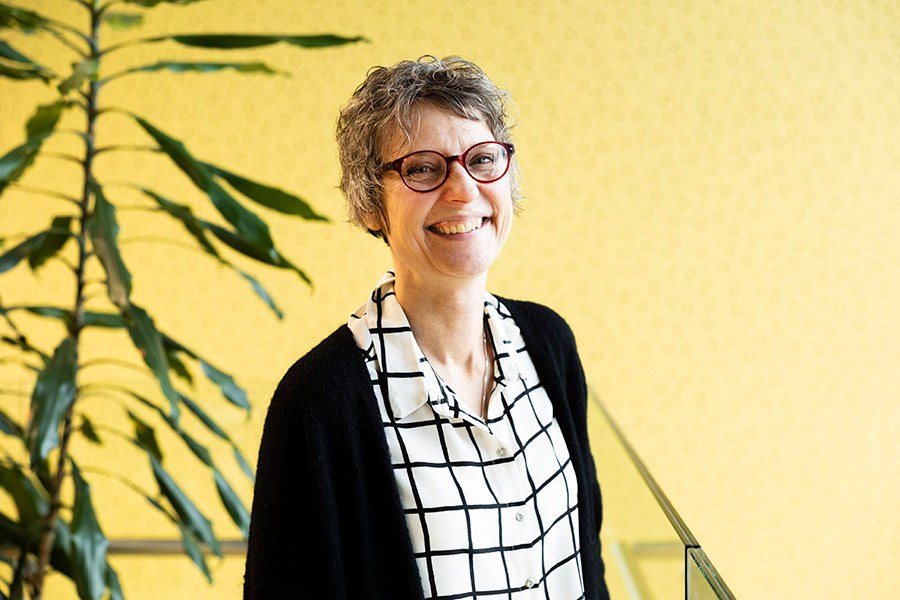Katri Lindfors is doing detective work to discover the reasons for the onset of celiac disease and varying symptoms

Why does celiac disease only develop in some of us and why does its clinical picture vary so much? Professor of Molecular Biology Katri Lindfors is trying to find answers to these questions.
“One patient’s celiac disease manifests as intestinal problems, another’s as skin symptoms, there are neurological symptoms in a third case while a fourth patient suffers from joint pain and a fifth from something else. My goal is to discover whether there are different types of hereditary predispositions or different immunological responses or mechanisms behind the divergent disease,” Lindfors says.
In solving the mystery of the onset of celiac disease, Lindfors and her colleagues utilise large patient material and the Finnish FinnGen data. FinnGen is an extensive biobank research project launched in 2017, where the genome data of half a million Finns was produced over a six-year period.
Another important clue is provided by the international Environmental Determinants of Diabetes in the Young (TEDDY) project. TEDDY is a birth cohort study where children are recruited from birth and followed up until fifteen years of age.
“Children with hereditary predisposition to type 1 diabetes are invited to the study. Because type 1 diabetes and celiac disease share the same genetic predisposition, some of the children will develop celiac disease during the follow-up period. For example, if a child develops celiac disease at the age of three, there is already a comprehensive set of samples of the child before the onset of the disease. In such research setting, you can get a good look at the factors that potentially lead to the causes of the illness,” Lindfors explains.
Among other things, similar follow-up studies have already found that children with celiac disease get more gluten from their diet in early childhood. There are also indications that certain types of infections, such as the enterovirus, could be linked to the development of celiac disease.

The question of why the clinical picture varies is more difficult to answer.
For example, it has been suggested that one of the causes of the skin manifestation, dermatitis herpetiformis (DH), is that the patient’s “normal” celiac disease is not diagnosed early enough, meaning the patient is not treated and the illness progresses to skin symptoms.
“However, little is known about the molecular mechanism behind DH. We have indications that certain types of hereditary factors could be a component. It is also known that DH involves an antibody response of its own kind. But so far, the answers to why the clinical picture of celiac disease varies remain open,” Lindfors points out.
Collaboration enables ground-breaking celiac research
In addition to being Professor of Molecular Biology, Lindfors is also Vice Director of the Celiac Disease Research Center (CeliRes) at Tampere University. A guiding light in the research conducted there is the hypothesis that the cause of DH and ‘traditional’ celiac disease is found in the small intestine.
“We use different methods and approaches to explore what may be happening in the small intestine of patients with DH and how these processes are eventually reflected on the skin. This is detective work, where finding one answer gives rise to ten new questions,” Lindfors says.
Although there are plenty of open questions, Lindfors thinks there is a good chance of finding the answers. In Finland, research on celiac disease already begun in the 1980s, and the research has been pioneering, which is something Tampere University can really boast about. A significant part of Finnish research takes place at Tampere University whose CeliRes research centre is also the only one of its kind in Finland.
“The research conducted in Tampere is also internationally recognised. Our strength is interdisciplinary research and investing in collaboration. Basic researchers like me work closely with clinicians, and doctors from different fields of medicine also work together in our group. We make use of the knowledge of many experts and take medicine forward. We are good!” Lindfors enthuses.
Would it be realistic, then, to expect that a solution to treat celiac disease in other ways than a gluten-free diet may be developed? That is the burning question in celiac disease research and things are already bubbling under.
“At the moment, the most promising treatment seems to be drug therapy, which blocks the activity of the enzyme transglutaminase 2 and prevents the damage gluten is causing in the small intestine. Emeritus Professor Markku Mäki from CeliRes is involved in this study. Various drug candidates are also being studied around the world, but at this point I put my money on ‘transglutaminase-2 inhibitor’ winning the lottery,” Lindfors explains.
Katri Lindfors
- Originally from Pirkkala
- Completed her PhD at Tampere University in 2004
- Started working as Vice Director of Celires in 2021.
- Appointed Professor of Molecular Biology at Tampere University in 2022.
New treatments for celiac disease
Celiac disease is an autoimmune condition that can develop at any age. At present, the only treatment for celiac disease is a completely gluten-free diet. The CeliRes research centre is Finland’s largest hub for research in celiac disease and conducts leading-edge multidisciplinary studies. By donating to celiac research, you are helping to develop diagnostics and treatment options.
Donate to celiac research as a private individual
Donate to celiac research on behalf of an organisation
Author: Sari Laapotti








